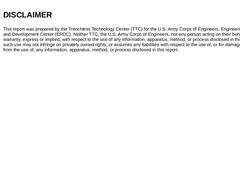
|
This report was prepared by the Trenchless Technology Center (TTC) for the U.S. Army Corps of Engineers, Engineering Research and Development Center (ERDC). Neither TTC, the U.S. Army Corps of Engineers, nor any person acting on their behalf, makes a warranty, express or implied, with respect to the use of any information, apparatus, method, or process disclosed in this report or that such use may not infringe on privately owned rights; or assumes … |
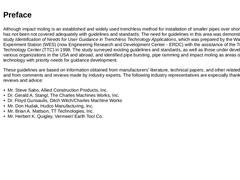
|
Although impact moling is an established and widely used trenchless method for installation of smaller pipes over shorter lengths, it has not been not covered adequately with guidelines and standards. The need for guidelines in this area was demonstrated in a study Identification of Needs for User Guidance in Trenchless Technology Applications, which was prepared by the Waterways Experiment Station (WES) (now Engineering Research and Development … |
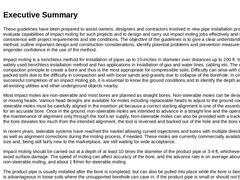
|
These guidelines have been prepared to assist owners, designers and contractors involved in new pipe installation projects to evaluate capabilities of impact moling for such projects and to design and carry out impact moling jobs effectively and safely, in consistence with project requirements and site conditions. The objective of the guidelines is to give a clear understanding of the method, outline important design and construction considerations, … |
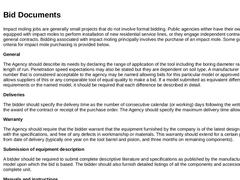
|
Impact moling jobs are generally small projects that do not involve formal bidding. Public agencies either have their own crews equipped with impact moles to perform installation of new residential service lines, or they engage independent contractors on general contracts. Bidding associated with impact moling principally involves the purchase of an impact mole. Some guidance on bid criteria for impact mole purchasing is provided below. |
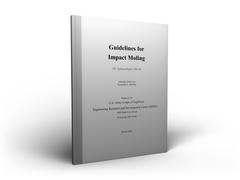
|
|
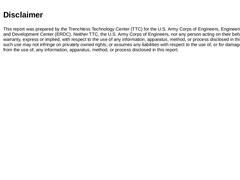
|
This report was prepared by the Trenchless Technology Center (TTC) for the U.S. Army Corps of Engineers, Engineering Research and Development Center (ERDC). Neither TTC, the U.S. Army Corps of Engineers, nor any person acting on their behalf, makes a warranty, express or implied, with respect to the use of any information, apparatus, method, or process disclosed in this report or that such use may not infringe on privately owned rights; or assumes … |
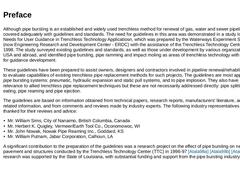
|
Although pipe bursting is an established and widely used trenchless method for renewal of gas, water and sewer pipelines, it is not covered adequately with guidelines and standards. The need for guidelines in this area was demonstrated in a study Identification of Needs for User Guidance in Trenchless Technology Applicatiosn, which was prepared by the Waterways Experiment Station (WES) (now Engineering Research and Development Center - ERDC) with … |
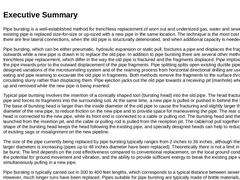
|
Pipe bursting is a well-established method for trenchless replacement of worn out and undersized gas, water and sewer pipes. An existing pipe is replaced size-for-size or up-sized with a new pipe in the same location. The technique is the most cost effective when there are few lateral connections, when the old pipe is structurally deteriorated, and when additional capacity is needed. Pipe bursting, which can be either pneumatic, hydraulic expansion … |
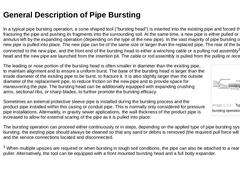
|
In a typical pipe bursting operation, a cone-shaped tool ("bursting head") is inserted into the existing pipe and forced through it, fracturing the pipe and pushing its fragments into the surrounding soil. At the same time, a new pipe is either pulled or pushed in the annulus left by the expanding operation (depending on the type of the new pipe). In the vast majority of pipe bursting operations, the new pipe is pulled into place. The new pipe can … |
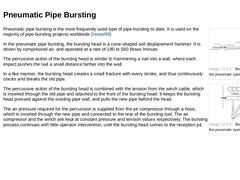
|
|
(Image: Bursting head of the pneumatic system [Sterl01])
|
|
(Image: Bursting head of the pneumatic system)
|
Pneumatic pipe bursting is the most frequently used type of pipe bursting to date. It is used on the majority of pipe bursting projects worldwide [Howel99] In the pneumatic pipe bursting, the bursting head is a cone-shaped soil displacement hammer. It is driven by compressed air, and operated at a rate of 180 to 580 blows /minute. The percussive … |
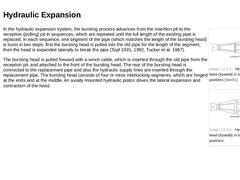
|
| (Image: Hydraulic bursting head (Xpandit) in contracted positions [Sterl01]) | | (Image: Hydraulic bursting head (Xpandit) in expanded positions) |
In the hydraulic expansion system, the bursting process advances from the insertion pit to the reception (pulling) pit in sequences, which are repeated until the full length of the existing pipe is replaced. In each sequence, one segment of the pipe (which matches the length of the bursting head) is burst … |
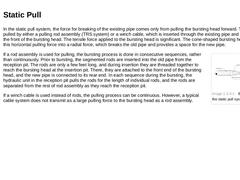
|
In the static pull system, the force for breaking of the existing pipe comes only from pulling the bursting head forward. The head is pulled by either a pulling rod assembly (TRS system) or a winch cable, which is inserted through the existing pipe and attached to the front of the bursting head. The tensile force applied to the bursting head is significant. The cone-shaped bursting head transfers this horizontal pulling force into a radial force, … |
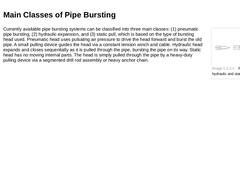
|
(Image: Pneumatic, hydraulic and static head [Sterl01]) Currently available pipe bursting systems can be classified into three main classes: (1) pneumatic pipe
bursting, (2) hydraulic expansion, and (3) static pull, which is based on the type of bursting head used.
Pneumatic head uses pulsating air pressure to drive the head forward and burst the old pipe. A small
pulling device guides the head via a constant tension winch and cable. Hydraulic head … |
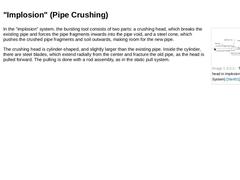
|
(Image: The crushing head in implosion (IMPIPE System) [Sterl01]) In the "implosion" system, the bursting tool consists of two parts: a crushing head, which breaks the existing pipe and forces the pipe fragments inwards into the pipe void, and a steel cone, which pushes the crushed pipe fragments and soil outwards, making room for the new pipe. The crushing head is cylinder-shaped, and slightly larger than the existing pipe. Inside the cylinder, there … |
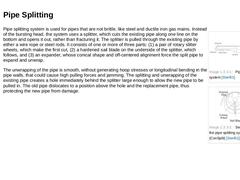
|
|
(Image: Pipe splitting system [Sterl01])
|
|
(Image: Section view of the pipe splitting system (ConSplit) [Sterl01])
|
Pipe splitting system is used for pipes that are not brittle, like steel and ductile iron gas mains. Instead of the bursting head, the system uses a splitter, which cuts the existing pipe along one line on the bottom and opens it out, rather than fracturing it. The splitter is pulled through the existing pipe by either a wire rope … |
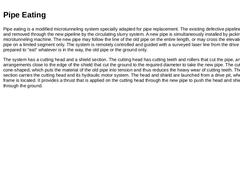
|
Pipe eating is a modified microtunneling system specially adapted for pipe replacement. The existing defective pipeline is crushed and removed through the new pipeline by the circulating slurry system. A new pipe is simultaneously installed by jacking it behind the microtunneling machine. The new pipe may follow the line of the old pipe on the entire length, or may cross the elevation of the old pipe on a limited segment only. The system is remotely … |
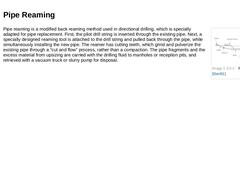
|
(Image: Pipe reaming [Sterl01]) Pipe reaming is a modified back reaming method used in directional drilling, which is specially adapted for pipe replacement. First, the pilot drill string is inserted through the existing pipe. Next, a specially designed reaming tool is attached to the drill string and pulled back through the pipe, while simultaneously installing the new pipe. The reamer has cutting teeth, which grind and pulverize the existing pipe … |
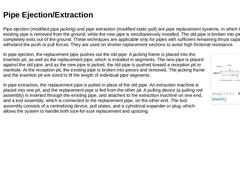
|
Pipe ejection (modified pipe jacking) and pipe extraction (modified static pull) are pipe replacement systems, in which the unbroken existing pipe is removed from the ground, while the new pipe is simultaneously installed. The old pipe is broken into pieces only as it completely exits out of the ground. These techniques are applicable only for pipes with sufficient remaining thrust capacity to withstand the push or pull forces. They are used on shorter … |
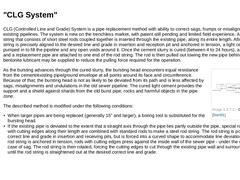
|
CLG (Controlled Line and Grade) System is a pipe replacement method with ability to correct sags, humps or misalignments in existing pipelines. The system is new on the trenchless market, with patent still pending and limited field experience. A steel rod string that consists of short steel rods coupled together is inserted through the existing pipe, along its entire length. After the rod string is precisely aligned to the desired line and grade … |
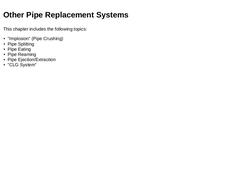
|
|
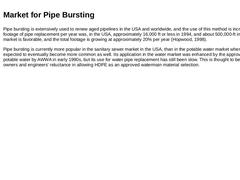
|
Pipe bursting is extensively used to renew aged pipelines in the USA and worldwide, and the use of this method is increasing. A total footage of pipe replacement per year was, in the USA, approximately 16,000 ft or less in 1994, and about 500,000-ft in 1997. The market is favorable, and the total footage is growing at approximately 20% per year (Hopwood, 1998). Pipe bursting is currently more popular in the sanitary sewer market in the USA, than in … |
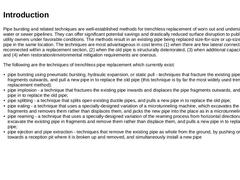
|
Pipe bursting and related techniques are well-established methods for trenchless replacement of worn out and undersized gas, water or sewer pipelines. They can offer significant potential savings and drastically reduced surface disruption to public and private utility owners under favorable conditions. The methods result in an existing pipe being replaced size-for-size or up-sized with a new pipe in the same location. The techniques are most advantageous … |
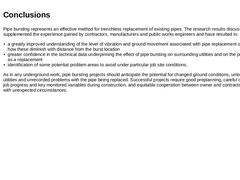
|
Pipe bursting represents an effective method for trenchless replacement of existing pipes. The research results discussed have supplemented the experience gained by contractors, manufacturers and public works engineers and have resulted in: - a greatly improved understanding of the level of vibration and ground movement associated with pipe replacement operations and how these diminish with distance from the burst location
- greater confidence in the …
|

|
|

|

This lecture is part of the series "Trenchless 101" and serves to provide an overview of trenchless replacement methods for supply and disposal lines. |